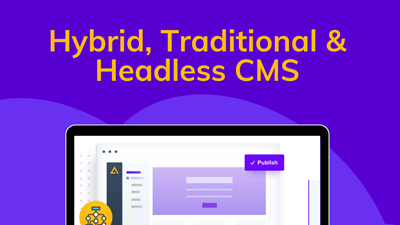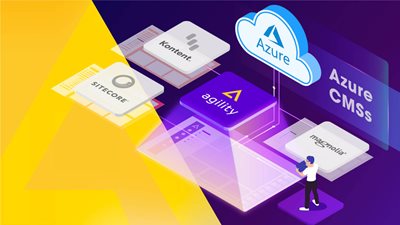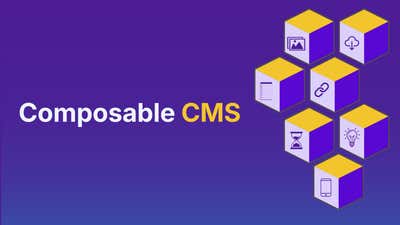Difference Between Traditional CMS And Headless CMS
Which Content Management Solution is Right for You?


When it comes to choosing a content management system, it’s a true balancing act between solving your biggest business challenges and catering to the multiple stakeholders who create your content. The decision-making process can feel confusing and overwhelming, especially since a silver bullet solution doesn’t exist.
Each CMS has its benefits and disadvantages, and what might work for one company might not work for yours, which poses the question, “What is the right CMS for my business?”.
There’s a wide scale of content management solutions to consider, from traditional page-based systems designed for editors to headless products built for developers and distributing content across channels; and, ultimately, hybrid systems, which can offer the best of both worlds, as well as connect and share data between channels.
As you evaluate your options and wade through all the tech jargon, here’s a brief guide to help you choose the best CMS for your website.
A Traditional CMS is Designed for Editors and Websites
Let’s start this by saying that traditional CMSs are design-centred. That means they are created to empower marketing editors with the greatest usability in creating a website and putting out content.
A traditional CMSIt offers a highly visual interface with built-in templates, modules, and control pages. Any content editor can create a website without knowing a word of code. You can preview content and see how it interacts with design using pre-built components. Also, editors can quickly and simply build on the CMS solution without needing development or developers.
While this kind of CMS is built for easily managing web pages, it tends to be too rigid to create more complex designs and integrate your content with other types of data.
Benefits of Traditional CMSs
The major benefit of traditional CMS is that the backend is completely tied to the front end. This often means that it’s not only easier for content developers to create and publish digital experiences, but it's also easier to manage the deployment in the long term.
Traditional CMSs also carry plenty of benefits for companies that aren’t looking into building omnichannel experiences.
Easy To Bring Employees On Board
Since the backend and the frontend are completely tied to each other, it’s often easier to bring employees together to collaborate and develop content.
Simpler Setup and Development
While this is debatable, and many CMSs (Agility included) make it simple for users to manage content, traditional CMSs are often easier to set up and deliver content effectively within the confines of the tool.
No Coding Knowledge Required
Traditional CMSs are often easier to maintain for non-technical users, making it simpler for users to manage the content editing process, even if they don’t know how to code.
Many Themes and Templates Available
Most traditional CMSs give you plenty of templates and themes to choose from, reducing the time it takes to get the look and feel of something.
Limitations of Traditional CMS for Complex Content and Enterprise Needs
While traditional CMSs offer convenience and simplicity for creating and managing web content, they come with limitations that can hinder the requirements of businesses with complex content structures and enterprise-level needs. Here are some of the problems associated with traditional CMSs when it comes to handling intricate content and catering to the demands of large-scale enterprises:
Lack of Flexibility for Complex Designs:
Traditional CMSs are primarily geared toward creating simple web pages with predefined templates and modules. As content requirements become more intricate and unique, these systems may struggle to provide the flexibility to accommodate complex layouts, custom data structures, and unconventional user experiences. Enterprises often require dynamic content presentation, which might involve intricate data relationships, personalized content delivery, and adaptive layouts – features that traditional CMSs may struggle to handle.
Integration Challenges:
Enterprises frequently deal with various data sources and systems, such as CRMs, ERPs, databases, and more. Integrating such data seamlessly with the content managed by a traditional CMS can be challenging. These CMSs are not designed to facilitate easy integration with external data sources, making creating unified and coherent experiences that leverage data from various platforms cumbersome.
Scalability and Performance:
As enterprise-level websites grow in content volume and user traffic, traditional CMSs might face scalability and performance issues. These systems may not be equipped to efficiently handle the increased load, resulting in slower page load times, unresponsive interfaces, and compromised user experiences.
Customization Constraints:
Enterprises often require unique functionalities and custom features beyond the capabilities of out-of-the-box solutions provided by traditional CMSs. While plugins and extensions can provide some level of customization, they might not fully address the specialized needs of an enterprise. This can lead to a heavy reliance on development teams, causing delays in implementing crucial features.
Versioning and Collaboration Challenges:
Effective content versioning, workflow management, and collaboration become critical in large enterprises with multiple departments and stakeholders. Traditional CMSs might lack advanced features for managing complex content approval workflows, multiple content contributors, and audit trails, making maintaining content consistency and accuracy challenging.
Security and Compliance Concerns:
Enterprises often need to adhere to strict security and compliance regulations, particularly when handling sensitive customer data. Traditional CMSs might not offer the robust security measures these organizations require, leaving them vulnerable to potential data breaches and compliance violations.
Omnichannel and Multichannel Support:
Enterprises need to deliver content across various channels and devices to reach their diverse audience. Traditional CMSs might struggle to provide seamless content distribution across multiple platforms, resulting in inconsistencies in branding, content presentation, and user experiences.
While traditional CMSs excel at providing user-friendly interfaces for creating and managing web content, they fall short when it comes to meeting the complex content and enterprise-level demands. Enterprises requiring intricate content structures, data integration, customization, scalability, security, and compliance need to explore more advanced content management solutions that cater to these specific requirements.
Headless CMS is Built for Developers
Compared to the rigidity of page-based Traditional systems, a Headless system offers the freedom to publish content, independent of presentation or design layers, and connect it to other channels. Content is stored centrally, typically on a cloud-based platform, and provided “as a service” to any application through APIs.
Built around the developer’s needs, a Headless CMS is ideal for complex designs and multiple integrations. Using their styles and favourite frameworks, developers can build and customize workflows from any platform (kiosks, apps, etc.), program language, or device. They can rapidly prototype content management features, tailoring aspects like user interface and modules.
IDC Futurescapes predicts that by 2020, the top mechanism for connecting data across digital chains will be APIs (flexible application programming interfaces). As a fully API-driven system, a headless CMS is designed to manage data as a web application, sending and receiving content and data across customer touchpoints.
The downside of Headless is that it’s just not as sophisticated as its Traditional predecessors. Marketing editors must publish content without a presentation layer or preview option (which can feel like writing in the dark). And while storing content separately from its presentation provides the flexibility to integrate with new channels, developers still have to build separate data pipelines for every touchpoint they add. This may not be too complex for building mobile apps and web applications, but connecting to the rest of your marketing stack might mean creating and maintaining multiple and individual integration points.
Benefits of Headless CMS
What truly makes a headless CMS better than a traditional CMS is its content-first approach with full APIs to access and display content in any way desired.
With this approach, a headless CMS enables you to author your content through RESTful APIs and deliver it wherever you need. If you want to create top-of-the-line content experiences, the headless approach might be right for you.
More Developer Flexibility
You can pick your programming language, and a headless CMS is API driven, so you can build your presentation layer end to end. Developers can work how they’re used to without conforming to any proprietary environment constraints.
Future-proof
A headless CMS allows you to structure your content to make new projects easier for future-proofing and when rebranding one or more channels because no technical changes are required within the CMS.
Supports Omnichannel Architectures
Instead of managing each channel separately, a headless CMS allows you to orchestrate a seamless experience that spans all touchpoints, maintaining consistency and relevance.
Always Up To Date
A huge benefit of a true, headless, multi-tenant system is that it's fully managed and upgraded for you. This is a huge benefit because upgrading can often be a costly project, not to mention that it's not very fun either, so your team will be very happy to hear this benefit!
Challenges and Considerations of Headless CMS
While headless CMS offers a range of benefits for enterprises and complex content needs, it's important to acknowledge the challenges and considerations of adopting this approach. Here are some of the issues that organizations, including enterprises, might encounter when implementing a headless CMS:
Increased Development Complexity:
While headless CMS empowers developers with flexibility, it is also responsible for building the presentation layer entirely on them. This can lead to increased development complexity and potentially longer implementation times, especially if the development team lacks experience with API integrations and front-end technologies.
Dependency on Development Resources:
Creating and maintaining a customized front-end presentation layer requires ongoing development resources. Enterprises without an in-house development team might need external developers, which can increase costs and lead to delays in updates and changes.
Content Preview Challenges:
With a decoupled architecture, previewing content in the context of the final design becomes more complex. Unlike traditional CMSs, where editors can see exactly how content will look on the website, a headless CMS might require additional tools or workflows to achieve accurate content previews across various channels.
Steep Learning Curve for Editors:
Content editors accustomed to traditional CMSs might find the transition to a headless CMS challenging. Working with APIs and potentially different interfaces for content creation and management could require additional training and adjustment time.
Content Structure Design:
A headless CMS often requires careful planning of content structures to ensure flexibility and reusability across various platforms. Poorly designed content structures could lead to inefficiencies, increased complexity in managing content relationships, and hinder future adaptations.
Integration Challenges:
While headless CMSs are designed for integration, connecting with external systems, third-party services, and databases can still present challenges. In some cases, integration might require custom development and technical expertise.
Potential Performance Overhead:
The additional layer introduced by the API-driven architecture might introduce some performance overhead compared to traditional monolithic CMSs. Organizations need to optimize API requests, implement caching strategies, and ensure efficient communication between the CMS and the presentation layer.
Security Considerations:
While headless CMSs can offer enhanced security features, the increased complexity of the architecture might also introduce new security considerations. Organizations need to ensure that APIs are properly secured and that sensitive data remains protected during content distribution.
Vendor Lock-in:
Depending on the headless CMS platform chosen, there could be concerns about vendor lock-in. Migrating content and integrations to a different platform in the future might be challenging and could potentially disrupt ongoing operations.
Total Cost of Ownership:
While headless CMSs might offer flexibility and content distribution benefits, the total cost of ownership could be higher than traditional CMSs. This includes the initial development costs and ongoing maintenance, updates, and potential integration expenses.
Although headless CMSs provide a powerful solution for enterprises and organizations with complex content needs, they also come with challenges that need careful consideration. Organizations should weigh the benefits against these challenges, assess their technical capabilities, and determine whether a headless CMS aligns with their content strategy and business objectives.
Headless CMS+ is Built to Connect Experiences
Cloud-first and API-based, a Headless CMS + solution leverage the cloud's speed and scalability for multi-channel scenarios. While Headless can distribute content across channels, Headless CMS + can seamlessly connect and share that content between marketing and sales pipelines, from customer touchpoints to ecommerce and transactional platforms, as well as marketing applications (like CRM, Salesforce, Flask, Microsoft Flow etc). The key benefit of a Headless CMS + solution is that it can integrate seamlessly into existing web channels, as well as with other CMS systems. Whether you implement it on its own or integrate it as a point solution, a Headless CMS + is designed to manage multi-channel content.
The agility of seamless integrations drives faster innovation and enables you to apply analytics and user data across channels to improve customer targeting and personalization. And what’s more, with fewer integration challenges across your entire digital landscape, the customer’s overall experience becomes more consistent.
What is the difference between headless and full CMS?
The digital world is vast and constantly evolving, and the heart of your online presence is your Content Management System (CMS). Understanding the difference between a traditional CMS and a headless CMS can be pivotal in how effectively you connect with your audience. Let's dive into what sets these two apart and how they can shape your digital strategy.
Traditional CMS: User-Friendly and Integrated
Imagine a traditional CMS like a classic car - it's a complete package, ready to drive off the lot. Platforms like WordPress and Joomla epitomize this, offering:
- Integrated Approach: These systems link content creation (backend) and presentation (frontend) seamlessly. They're like a Swiss Army knife, equipped with all the tools for building and managing a website.
- Focus on Presentation: With a range of themes and templates, they make your content not just readable but visually appealing.
- Ease of Use: Their user-friendly interfaces are ideal for those who want to focus more on content and less on technicalities. The WYSIWYG editors ensure that what you see is indeed what you get.
- Flexibility Constraints: However, this ease comes with a trade-off in flexibility. Customizing your site or integrating new tech can sometimes feel like fitting a square peg into a round hole
Headless CMS: Agile and Future Ready
Now, picture a headless CMS as a high-tech drone - versatile and ready to fly anywhere.
- Decoupling Content and Delivery: They separate content creation from delivery, much like having a skilled pilot (backend) controlling a drone (frontend) from anywhere.
- API-Driven: These CMSs use APIs to deliver content, meaning your message can land anywhere - be it websites, mobile apps, or even IoT devices.
- Flexibility and Scalability: This separation allows for unparalleled flexibility. Whether you’re scaling up or shifting strategies, a headless CMS adapts swiftly.
- Technical Savvy Required: However, this flexibility demands a higher level of technical expertise. It's like flying a drone – thrilling but requiring skill.
Making Your Choice
Deciding between a traditional and a headless CMS is like choosing between a classic car and a high-tech drone. Each has its charm and challenges. Your choice depends on your journey – do you prefer a ready-to-go solution, or are you looking for something that flies high and reaches far?
In the dynamic digital space, your CMS is not just a tool; it's your companion. Choose wisely, and set the course for your digital adventure!
Benefits of a Headless CMS +
Headless CMS +s combine the benefits of modern headless architecture and the ease of use of traditional content management, including collaboration and scalability for big or small organizations.
The best thing about Headless CMS +s is that they provide the best headless and traditional CMSs. They represent a solid middle ground where your company can stand. Here are some of the main benefits of a Headless CMS +
Cloud-based
Hybrid systems are often cloud-ready or cloud-based, meaning different team members can make changes and edit content in real-time without hindering the rest of the team.
Fosters collaboration
Hybrid content management systems foster collaboration between the marketing and development teams by creating an environment where they can all create digital experiences to delight your audience.
What is the Downside of headless CMS?
While a Headless CMS combines the advantages of traditional content management and headless architecture, it's important to recognize that this approach also brings challenges and considerations. Here are some issues that organizations, especially enterprises, might encounter when adopting a Headless CMS:
Complexity of Integration:
While Headless CMSs tout their integration capabilities, connecting different systems and platforms can still present challenges. Ensuring seamless data flow between the traditional presentation layer and headless architecture might require careful planning, development effort, and ongoing maintenance.
Customization Trade-offs:
Headless CMSs aim to balance user-friendliness for marketers with developer flexibility. However, finding the right balance can be a challenge. Customizing the system to meet specific business needs might require trade-offs between ease of use and advanced functionality.
Learning Curve for Editors:
While Headless CMSs offer user-friendly interfaces, the combination of traditional and headless features might lead to a learning curve for content editors who are new to the system. Editors will need to understand both the traditional page-driven approach and the headless content delivery model.
Vendor Dependency:
Organizations adopting a Headless CMS might become dependent on a particular vendor's technology and services like any other CMS solution. This dependency could lead to potential challenges if the vendor's offerings change or if migration to a different platform is necessary.
Maintenance and Updates:
A Headless CMS introduces complexity in traditional content management and headless architecture. This complexity can impact the frequency and ease of updates and maintenance. Organizations must plan for regular updates to ensure security, performance, and access to the latest features.
Content Preview Challenges:
Like headless CMSs, Headless CMSs might face challenges when providing accurate content previews across various channels. Ensuring editors can visualize how content will appear on different platforms requires additional tools or workflows.
Scalability Considerations:
While Headless CMSs leverage cloud infrastructure for scalability, organizations must ensure that the system is designed to handle the increased load of content distribution and integrations across multiple channels without compromising performance.
Cost Complexity:
Combining traditional and headless features could lead to a complex cost structure. Organizations need to evaluate the total cost of ownership, including licensing fees, integration costs, development expenses, and ongoing maintenance.
Migration from Existing Systems:
The migration process can be intricate if an enterprise transitions from a traditional CMS to a hybrid solution. Ensuring existing content, templates, and functionalities seamlessly transition to the new architecture requires careful planning and execution.
Data Consistency:
Maintaining data consistency and accuracy can be challenging with content distributed across different systems and platforms. Organizations need to implement effective content management strategies to prevent discrepancies and ensure a unified user experience.
Organizations, particularly enterprises, should carefully assess their content strategy, technical capabilities, and business goals to determine whether a Headless CMS aligns with their requirements and can effectively address their content management needs.
Evolving Beyond: The Rise of Headless CMS+
As the landscape of content management systems continues to evolve, a new player emerges on the scene - Headless CMS+. This innovative approach combines the strengths of both traditional and headless architectures, aiming to provide a holistic solution that caters to a wide range of business needs. Here's a closer look at the concept of Headless CMS+ and the benefits it brings to the table:
Headless CMS+ Unveiled
Headless CMS+ integrates the best elements from traditional and headless CMS models into a single solution. It offers a presentation layer for easy content editing and website management, similar to traditional CMSs. Simultaneously, it provides the flexibility of a headless CMS by offering APIs to distribute content across various channels and devices.
What sets the Headless CMS+ apart is its incorporation of layouts. Unlike headless, hybrid, and traditional CMSs, which often require developers to manually build and structure pages, the Headless CMS+ introduces the concept of layouts. These layouts enable content editors and marketers to design and assemble web pages with a decoupled architecture without relying heavily on technical resources. This feature enhances user experience by empowering non-technical users to create dynamic and visually appealing content layouts while still benefiting from headless capabilities.
Benefits of Headless CMS+
The advantages of adopting a Headless CMS+ are manifold and can address several pain points faced by businesses:
Unified User Experience:
Like traditional systems, the Headless CMS+ allows businesses to manage their content through a user-friendly interface. This means marketers and content editors can create and modify content without requiring in-depth technical knowledge.
Enhanced Flexibility:
By offering APIs for content distribution, the Headless CMS+ empowers developers to create custom experiences for different channels and devices. This flexibility enables businesses to adapt to changing user preferences and technological advancements.
Efficient Collaboration:
The Headless CMS+ fosters collaboration between marketing and development teams. Content editors can work within a familiar interface, while developers can focus on creating dynamic and interactive front-end experiences using APIs.
Multi-Channel Support:
Like headless CMSs, the Headless CMS+ allows content to be distributed seamlessly across various touchpoints, ensuring consistent branding and messaging across platforms.
Time and Cost Savings:
Integrating presentation and headless capabilities within a single CMS solution can save time and cost. There's no need to implement and manage separate systems for different requirements.
Adaptability for Future Growth:
The Headless CMS+ supports future scalability and growth. Businesses can expand their digital presence, incorporate new channels, and adapt to emerging technologies without significant disruptions.
Layouts for Content Creation:
Including layouts empowers content editors to design and structure web pages without extensive technical knowledge. This bridges the gap between content creation and technical implementation, streamlining the process.
White Glove Service:
The Headless CMS+ comes with white glove service, providing a complete solution. This personalized support ensures businesses receive guidance, training, and assistance in utilizing the CMS effectively, reducing the learning curve and potential obstacles.
Handling Complex Content:
With its layout capabilities and headless architecture, the Headless CMS+ can handle complex content structures, enabling businesses to present intricate data, personalized experiences, and adaptive layouts.
Challenges and Considerations of Headless CMS+
While the Headless CMS+ offers a promising solution, it's important to consider potential challenges:
Vendor Selection:
The market for Headless CMS+ solutions might be limited compared to traditional or headless systems. Choosing the right vendor that aligns with your business goals is crucial.
Learning Curve:
Businesses adopting a Headless CMS+ may need to ensure that content editors and developers understand the functionalities and how to utilize them effectively.
Choosing the Right Path Forward
The Headless CMS+ presents a promising middle ground to bridge the gap between traditional and headless content management solutions. Combining the strengths of both models, it offers businesses a comprehensive toolset to meet diverse needs. However, as with any CMS decision, organizations should carefully evaluate their specific requirements, technical capabilities, and long-term goals before embracing the Headless CMS+ approach. As the digital landscape evolves, finding the CMS that strikes the right balance between simplicity and flexibility will be essential to staying ahead in a competitive market.
A Headless CMS+ Success Story
Cineplex leverages APIs To Provide Better User Experiences.
Cineplex, a Canadian entertainment company, successfully used Agility CMS to redesign their websites and integrate them with new technologies (like responsive and mobile) without rebuilding their backend. Agility offered them one responsive solution to change and enhance their digital properties through front-end design.
It also enabled them to structure content in a way that supported their developers and editors and created a workflow for both teams to work together. While developers were free to implement format-neutral content, editors could manage content from a page perspective and distribute it to other platforms and feeds. They could also seamlessly integrate content with their circle of other marketing platforms, from apps and feeds to movie databases, an online store, and an enhanced ticketing system.
With headless CMS+, Cineplex could deliver page-driven content across channels and distribute it through APIs. And since they could implement all of these changes without rebuilding from the ground up, they could invest the time and money they saved into the actual growth of their business.

About the Author
Joel is CTO at Agility. His first job, though, is as a father to 2 amazing humans.
Joining Agility in 2005, he has over 20 years of experience in software development and product management. He embraced cloud technology as a groundbreaking concept over a decade ago, and he continues to help customers adopt new technology with hybrid frameworks and the Jamstack. He holds a degree from The University of Guelph in English and Computer Science. He's led Agility CMS to many awards and accolades during his tenure such as being named the Best Cloud CMS by CMS Critic, as a leader on G2.com for Headless CMS, and a leader in Customer Experience on Gartner Peer Insights.
As CTO, Joel oversees the Product team, as well as working closely with the Growth and Customer Success teams. When he's not kicking butt with Agility, Joel coaches high-school football and directs musical theatre. Learn more about Joel HERE.




